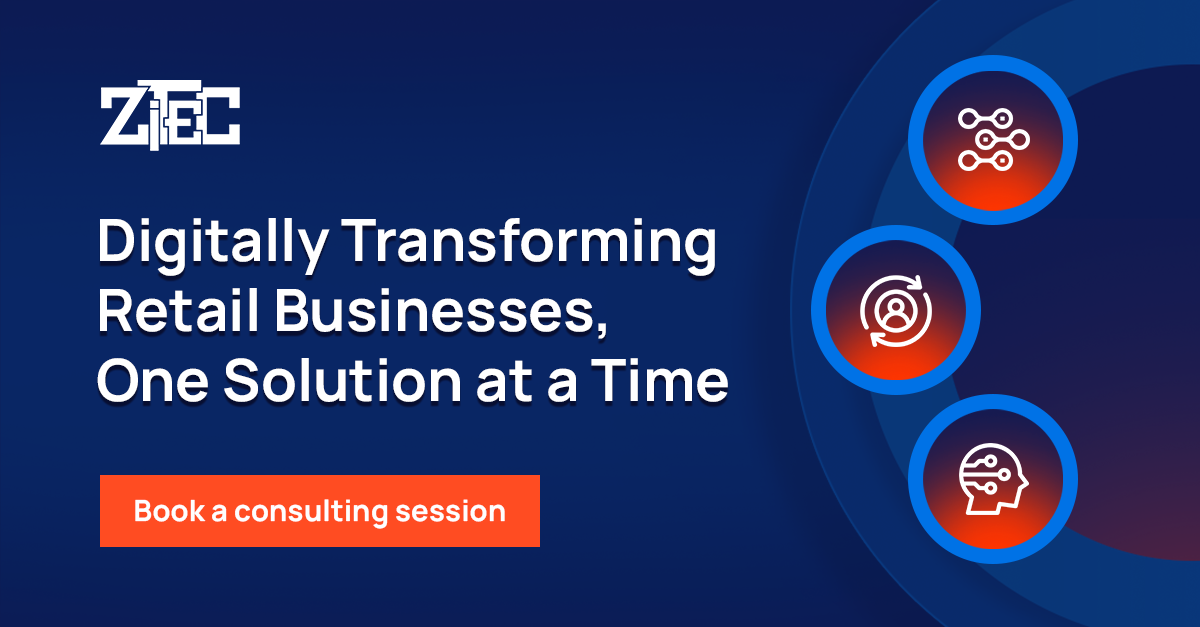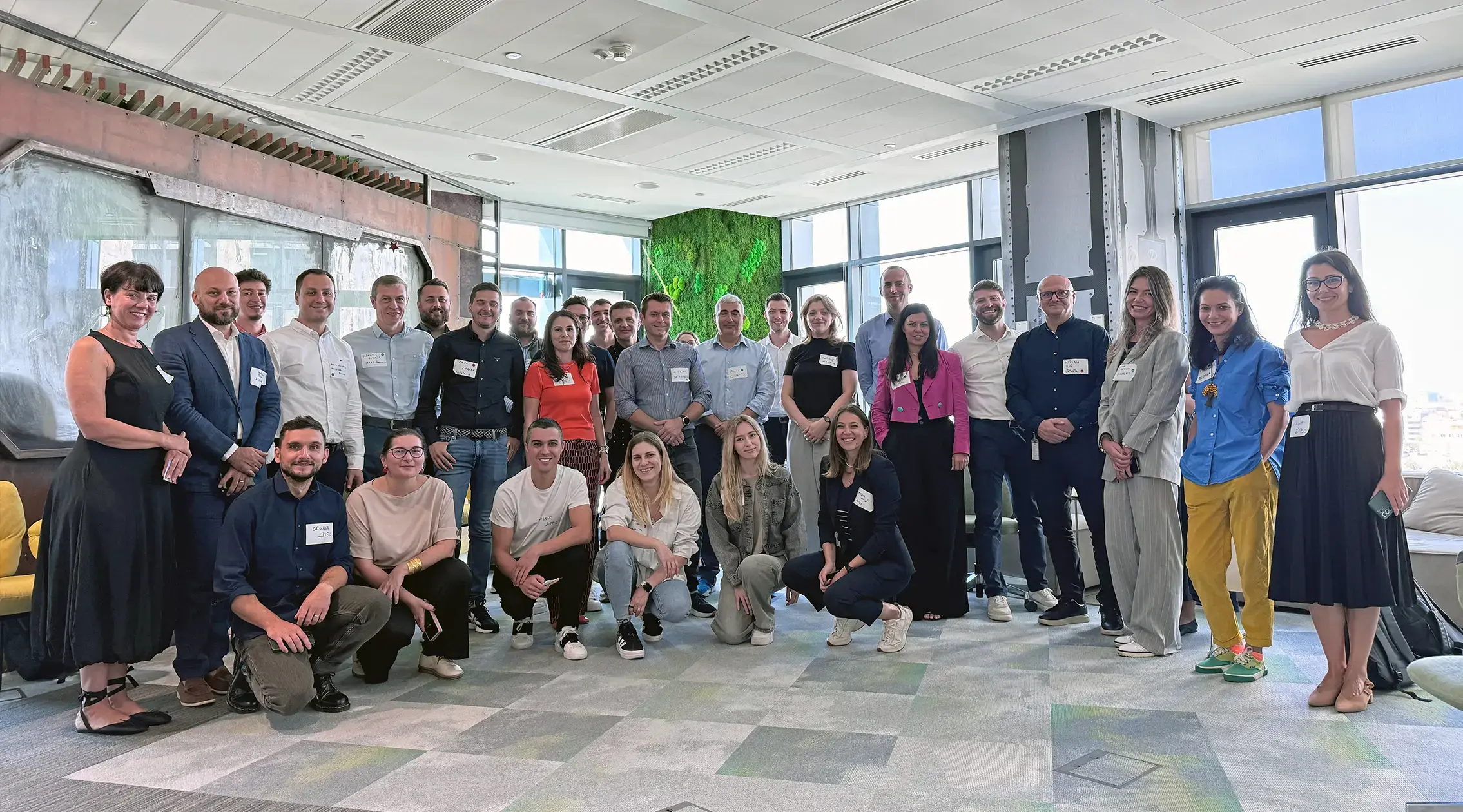Retail, as we know, is changing fast. As digital innovation and artificial intelligence continue integrating into shopping experiences, the future of retail is shifting from what might’ve looked like an expected course. Consumers today demand personalization, seamless interactions, and frictionless omnichannel experiences.
With AI partly driving this digital transformation, faster checkout times or product recommendations won’t cut it anymore. The entire retail journey is being reimagined from the supply chain to the in-store and the online shopping experience. Will these technologies simply complement the traditional retail model, or will they completely reshape it? The signs point towards the latter. Let’s explore why.
What does the Future of Retail Look Like? Industry Experts Answered.jpeg?width=2048&height=1365&name=Radu%20-%20EDC%20(1).jpeg)
Change is a term we often hear in fields directly impacted by consumers, such as retail. But, after conversing with top retail minds in the industry, some questions emerged: how does it manifest? Is change linked to customer behavior, new technologies, and evolving business models? Truthfully, it’s all of them. Let’s get into more details.
1. Digital transformation is still at the forefront of the retail industry
.webp?width=1650&height=1200&name=retail-transformation%20(1).webp)
Digital transformation continues to redefine the retail landscape, way beyond isolated tech upgrades, becoming the backbone of any modern strategy for retailers all over.
As Alex Dobre, our Retail & Distribution Director shared in a recent interview (Romanian), this transformation is inevitable and essential to maintain competitiveness. Retailers are taking note: from AI-powered customer insights and automated operations to the digital interactions that meet today’s demand for personalization and convenience, a shift is happening.
- On one hand, a well-optimized eCommerce platform is key — one that improves customer experience and includes scalable functionalities to keep pace with shifting customer demands.
- On the other hand, retail success now hinges on unified omnichannel experiences, where digital and physical meet seamlessly. Consumers expect consistent interactions across online and offline channels, which drives retailers to reimagine their business models.
Technologies driving change
Retail's future is being shaped by a series of emerging technologies, including:
- AI & ML
- AR/VR
- Big data
- Cloud computing
- Digital payments
When it comes to advanced digital tools, AI-powered demand forecasting or conversational chatbots are just a few of the most sought-after solutions and opportunities that help retailers quickly respond to market changes.
2. Omnichannel strategies are key to meeting consumer expectations
 Source
Source
Customers today expect nothing less than seamless, personalized experiences across all platforms. Whether they’re shopping:
- In-store (brick and mortat retail)
- Online (via the website, a landing page, other vendors)
- Through a mobile app (via the company's custom app, loyalty app, or social commerce media)
They need consistency across every touchpoint. Failing to deliver on these expectations could translate to a loss of brand loyalty and competitiveness in this sector.
"In our day-to-day consulting work, we notice a growing demand for unified omnichannel models, where consumers expect a consistent experience across both online and offline channels at every stage of their purchasing journey." - Alex Dobre, Zitec’s Retail & Distribution Director.
When technology with strategy, retailers are better equipped to meet consumers where they are. This helps them provide familiar, accessible, and dependable offline and online shopping experiences.
Key elements of a top omnichannel strategy
.webp?width=5696&height=3661&name=IMG_0298%20(1).webp)
A high-performing omnichannel strategy includes several key elements, such as:
- Syncing stock across online and offline channels allows customers to check product availability in real time and choose how they want to purchase going forward.
- Presenting uniform branding and consistent messaging across digital and physical stores to reinforce brand identity and build trust.
- Providing responsive customer service across platforms — be it through in-app messaging, chatbots, or in-store representatives.
|
Just recently, KFC developed a new online platform in collaboration with Zitec and VTEX as part of their omnichannel approach. Customers can now access KFC’s entire menu through an easy-to-use digital platform that mirrors the in-store experience, available across desktop and mobile. This unified platform allows KFC fans to seamlessly switch between ordering from home or checking availability at a nearby restaurant while enjoying a consistent brand experience. |
3. Retailers must separate AI’s hype from its real impact
Is AI in retail still a somehow distant idea? Not really.
In a recent interview, our retail business line director was asked about how this technology’s impact defines various retail operations, from customer service chatbots to predictive analytics and personalized marketing. Top insights include:
Personalized customer experiences
In the retail industry, AI is being used more and more to anticipate customer needs. AI analyzes customer data, such as purchase history, browsing and shopping habits, and even online interactions, to deliver hyper-personalized product recommendations. The result? A boost in both sales and customer satisfaction.
AI-powered personalization usually works through predictive AI, which analyzes customer behavior to anticipate future purchases, real-time personalization, which dynamically adjusts recommendations based on live interactions, and omnichannel syncing, aimed to achieve a seamless experience across mobile, web, and in-store.
Inventory management and supply chain optimization
Here we’re talking about algorithms that can predict product demand and adjust inventory levels accordingly, reducing overstocking or stockouts. McKinsey estimates that AI-driven supply chain improvements can improve logistics costs by 15% and inventory levels by 35%.
AI-driven chatbots for customer service
 Source
Source
Available 24/7, such virtual assistants handle routine inquiries, track orders, and offer recommendations based on customer behavior. This reduces the burden on human customer service teams, speeds up response times, and enhances customer satisfaction.
According to Gartner, by 2028, 30% of Fortune 500 companies will provide customer service exclusively through a single AI-powered channel.
The real power of AI assistants lies in their ability to learn from customer interactions and refine their responses. But for an AI chatbot to work accurately, certain criteria must be considered:
- Choosing the right AI framework – Businesses should consider relying on technologies like Generative AI (like GPT-4, Claude, or Gemini) for natural conversations, Predictive AI for anticipating user needs, and Machine Learning (ML) for continuous improvement.
- Integrating with backend systems – A well-implemented AI assistant connects to ERP, CRM, and supply chain platforms for real-time order tracking and proactive updates.
- Optimizing with predictive analytics – Anticipating customer needs and offering tailored suggestions is slowly becoming a given of any proper AI-powered assistant. Bank of America’s Erica AI assistant, for example, identifies spending patterns and offers proactive financial advice for tens of millions of customers.
To make AI-powered virtual assistants work even better, companies must understand that refining AI models is an ongoing process, including analyzing chatbot logs, tracking customer sentiment, and integrating reinforcement learning.
4. Cost-cutting might occur through efficiency and automation, not lowering investments 
Strategic investments in automation and efficiency become a powerful approach to:
- Reduce errors
- Streamline operations
- Improve profitability in areas like order processing, inventory tracking, or customer service
With the right AI model, e.g. ML-driven solutions, such investments turn into powerful assets that strengthen business models from the grounds-up even long after deploying, as the AI gathers insights from ongoing processes and refines them continuously.
While individual automation solutions can be implemented quickly, more complex, business-wide transformations, such as fully integrated supply chain management systems or predictive analytics platforms, often require a structured and incremental approach, like developing an MVP.
A phased MVP approach allows retailers to test the waters, deploying low-risk, high-impact automation solutions that address immediate operational pain points, such as order processing, inventory tracking, or customer service, without significant upfront investment.
5. Data-driven retail will shape smarter business decisions
Data analytics, especially when paired with AI, allows retailers to deliver on a wide span of digital transformation goals, from improving CX to driving loyalty, and retention, and efficientizing business operations.
Using technologies like AI predictive analytics, generative AI, and machine learning running on cloud data warehouses that make it easy to manage large datasets and run complex queries, retailers can use data analytics to gain granular insights into customer preferences and habits, allowing for hyper-personalized eCommerce marketing, dynamic pricing, tailored recommendations, and more.
Google’s recommendation engine is a prime example, using purchase history and browsing behavior to tailor suggestions and drive higher conversion rates. By analyzing similar consumer data, retailers can predict demand more accurately, adjust product offerings seasonally, and fine-tune marketing messages to align with customer expectations.
Internally, data can transform supply chain and inventory management through real-time data from stores. Additionally, predictive analytics can forecast purchasing patterns to avoid costly overstocking or stockouts.
6. Driving loyalty is an imperative
Customer loyalty app developed by Zitec for Ivatherm – leading dermato-cosmetic retailer
Loyalty has evolved from simple rewards to a comprehensive strategy that strengthens the connection between brand and customer. Today, loyalty programs must create value-rich, engaging experiences that resonate long after a purchase.
For that, successful loyalty programs need to blend tangible rewards with moments that make customers feel valued. A loyalty program that recognizes individual preferences or milestone events (like birthdays or anniversaries) builds a deeper relationship than one that’s purely points-based.
|
For example, in our recent work with a top Romanian dermo-cosmetic brand, we developed a loyalty program designed to go beyond order-based rewards. The program integrates engagement-based incentives, allowing members to earn points through activities like writing reviews, subscribing to newsletters, and interacting on social media. This multi-layered approach created an immersive loyalty experience, driving results such as a 58% higher Lifetime Value (LTV) for digital club members compared to guest users. Moreover, these members generated 46% of revenue from all registered users. |
Moreover, loyalty must go beyond transactions. Many leading brands reward social media engagement, product reviews, and brand referrals, transforming customers into advocates.
“Today’s consumers expect brands to offer some type of value exchange in return for their engagement. This is why implementing a customer loyalty program was a top priority for us. And knowing that loyalty isn’t built solely on repeat purchases, we wanted to deliver a rewarding customer journey blending shopping benefits with meaningful brand connections. Partnering with Zitec was a game-changer. Their expertise in building bespoke digital products and the deep understanding of the retail landscape helped us create this innovative loyalty program, that truly elevated our customer engagement strategy. We're already seeing positive results, allowing us to connect with our customers on a deeper level while delivering unparalleled value and rewards.” - Roxana Dirlau, eCommerce & Digital Manager, Ivatherm
What’s next for the retail industry? 
As retail continues to evolve, digital transformation should remain a key priority for industry leaders. The key trends we highlighted, from omnichannel strategies to data-driven insights and loyalty-focused initiatives, are only going to grow in complexity.
Hence, success in retail lies in creating seamless, engaging, and personalized experiences. Resistance to this digital transformation limits growth, so finding the right technological partner to guide this journey can be invaluable.
At Zitec, we bring a proven approach with a 9/10 success rate on delivering projects on time and on target, starting with an MVP and ending with an impact-driven solution aligned with your vision.
Curious about how digital solutions could shape the future of retail for your organization? 




.webp)